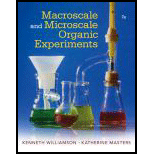
Macroscale and Microscale Organic Experiments
7th Edition
ISBN: 9781305577190
Author: Kenneth L. Williamson, Katherine M. Masters
Publisher: Brooks Cole
expand_more
expand_more
format_list_bulleted
Question
Chapter 8, Problem 8Q
Interpretation Introduction
Interpretation:
The necessity of conducting TLC in a closed chamber and saturation of interior with vapor of the solvent should be determined.
Concept introduction:
Thin layer chromatography works on the basic principle of separation of the constituents of the sample based on its interaction with the mobile and the stationary phase. The sample depending on the extent of its polarity gets separated on the stationary phase under the influence of the mobile phase.
Expert Solution & Answer
Trending nowThis is a popular solution!

Students have asked these similar questions
For questions 1-4, consider the following complexes:
[Co(CN)6]4,
[COC14]²,
[Cr(H2O)6]²+
1. Assign oxidation number to the metal, then indicate d-electron count. (3 points)
Using iodometry I want to titrate a sodium thiosulfate solution and I use 15 mL. If I have 50 mL of a 0.90 M copper solution and KI, what will be the molarity of sodium thiosulfate?
Draw the product formed when the following pair of compounds is treated with NaOEt in ethanol.
+
i
CN
Chapter 8 Solutions
Macroscale and Microscale Organic Experiments
Ch. 8 - Prob. 1QCh. 8 - Prob. 2QCh. 8 - What problem will ensue if the level of the...Ch. 8 - Prob. 4QCh. 8 - Prob. 5QCh. 8 - Arrange the following in order of increasing Rf...Ch. 8 - What will be the result of applying too much...Ch. 8 - Prob. 8QCh. 8 - Prob. 9QCh. 8 - A TLC plate showed two spots with Rf values of...
Knowledge Booster
Similar questions
- I need help with the followingarrow_forwardI need help with the followingarrow_forwardFor Raman spectroscopy/imaging, which statement is not true regarding its disadvantages? a) Limited spatial resolution. b) Short integration time. c) A one-dimensional technique. d) Weak signal, only 1 in 108 incident photons is Raman scattered. e) Fluorescence interference.arrow_forward
- Using a cell of known pathlength b = 1.25115 x 10-3 cm, a water absorption spectrum was measured. The band at 1645 cm-1, assigned to the O-H bending, showed an absorbance, A, of 1.40. a) Assuming that water density is 1.00 g/mL, calculate the water molar concentration c (hint: M= mole/L) b) Calculate the molar absorptivity, a, of the 1645 cm-1 band c) The transmitted light, I, can be written as I= Ioexp(-xb), where x is the absorption coefficient (sometimes designated as alpha), Io is the input light, and b is the cell pathlength. Prove that x= (ln10)*x*c. (Please provide a full derivation of the equation for x from the equation for I). d) Calculate x for the 1645 cm-1 bandarrow_forwardI need help with the follloaingarrow_forwardFor a CARS experiment on a Raman band 918 cm-1, if omega1= 1280 nm, calculate the omega2 in wavelength (nm) and the CARS output in wavelength (nm).arrow_forward
- I need help with the following questionarrow_forwardFor CARS, which statement is not true regarding its advantages? a) Contrast signal based on vibrational characteristics, no need for fluorescent tagging. b) Stronger signals than spontaneous Raman. c) Suffers from fluorescence interference, because CARS signal is at high frequency. d) Faster, more efficient imaging for real-time analysis. e) Higher resolution than spontaneous Raman microscopy.arrow_forwardDraw the major product of the Claisen condensation reaction between two molecules of this ester. Ignore inorganic byproducts. Incorrect, 5 attempts remaining 1. NaOCH3/CH3OH 2. Acidic workup Select to Draw O Incorrect, 5 attempts remaining The total number of carbons in the parent chain is incorrect. Review the reaction conditions including starting materials and/or intermediate structures and recount the number of carbon atoms in the parent chain of your structure. OKarrow_forward
arrow_back_ios
SEE MORE QUESTIONS
arrow_forward_ios
Recommended textbooks for you
 Principles of Instrumental AnalysisChemistryISBN:9781305577213Author:Douglas A. Skoog, F. James Holler, Stanley R. CrouchPublisher:Cengage Learning
Principles of Instrumental AnalysisChemistryISBN:9781305577213Author:Douglas A. Skoog, F. James Holler, Stanley R. CrouchPublisher:Cengage Learning

Principles of Instrumental Analysis
Chemistry
ISBN:9781305577213
Author:Douglas A. Skoog, F. James Holler, Stanley R. Crouch
Publisher:Cengage Learning